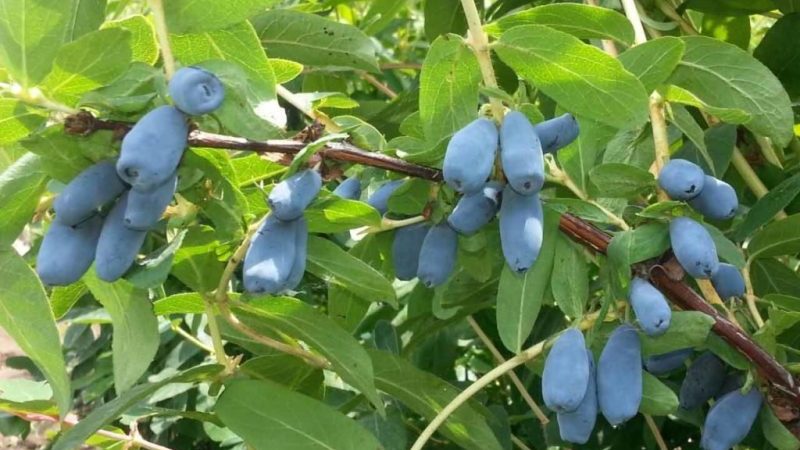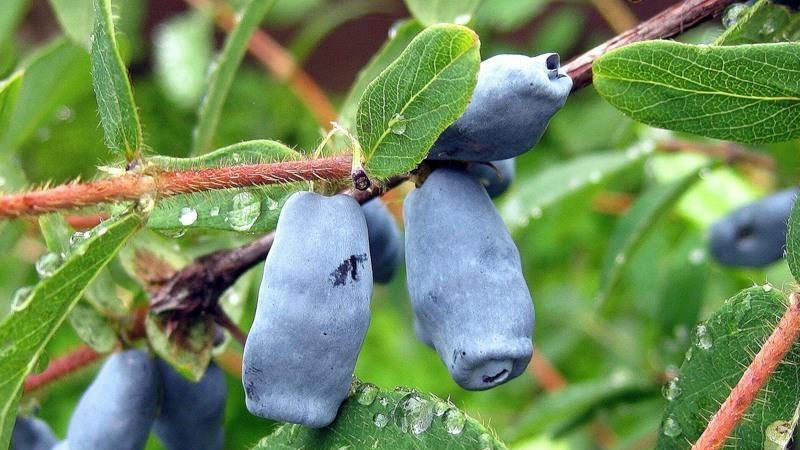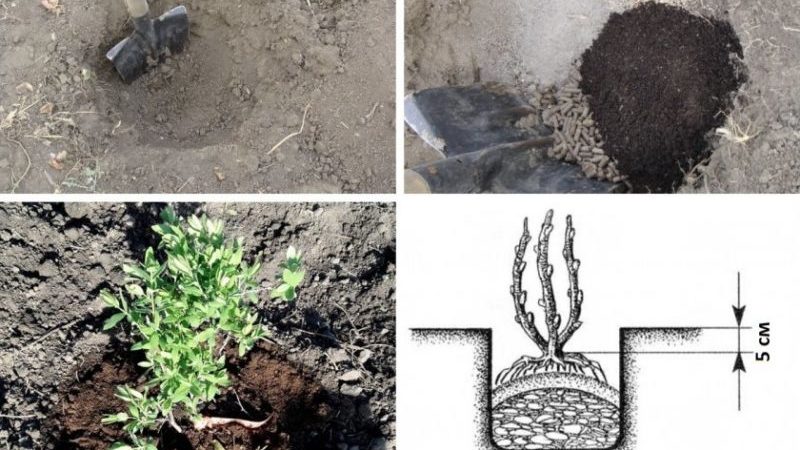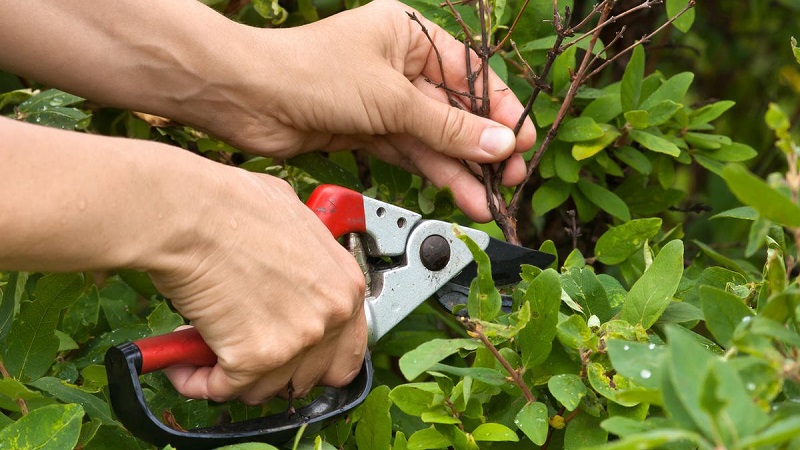All about edible honeysuckle: how long it lives, how it looks and is grown
Edible honeysuckle is a bush with yellow flowers that will decorate any garden. It produces tasty and healthy fruits that are rich in vitamins and minerals. But despite the unpretentiousness and frost resistance of culture, it is still rarely found on personal plots. Read all about honeysuckle below.
The content of the article
Description of edible honeysuckle
Edible honeysuckle is a species of the genus Honeysuckle. Originally a wild plant that has been cultivated by breeders. It is used to decorate the site and get useful berries.
The culture is undemanding to care for and is able to grow in harsh conditions.
What is it - a bush or a tree

Honeysuckle is not a tree, but a shrub that grows up to 2 m in height. It has a spherical crown and yellowish bark, which is divided into narrow stripes on old branches. The root system is branched. Most of the roots are located at a depth of 0.5 m.
The leaves of fruit honeysuckle are oblong, lanceolate, narrow, about 5 cm long.
How and when it blooms
The shrub blooms in late April or early May. Honeysuckle flowers are funnel-shaped, light yellow in color. The length of the rim is about 1 cm.
What does a berry look like

Honeysuckle fruits are blue berries with a delicate skin and a waxy coating. The shape is different, but most often it is cylindrical.
Reference. The first berries ripen at the end of May, ripen en masse in June.
The weight of one berry reaches 2 g. The size varies from 1 to 4 cm. The maximum diameter is 2 cm. Inside the berry there are flat light seeds (up to 20 pieces).
The taste depends on the climate - the warmer, the sweeter. It can be sweet, sweet and sour, sour, or even bitter. Berries contain magnesium, potassium, vitamin C, vitamin PP, carotene, pectins, organic acids, and sugars.
Origin
It is believed that honeysuckle originated in the Kuril Islands. After that, it spread throughout the north of the entire planet.
Where do you come from
Blue honeysuckle distributed in regions with cold and temperate climates. This is the north of Canada, Asia and Europe.
The fruits of the plant have been known for centuries. Previously in Japan, berries were used as a remedy. The Japanese were the first to create new crop varieties.
In the 30s of the last century, Russian breeders followed in their footsteps, and then Canadian ones. Today there are many varieties that are suitable for industrial cultivation.
Why is it called so

There are several points of view about the origin of the name. It is assumed that this word was transformed from "zymolist", since the foliage of the plant does not fall off until late autumn.
Others believe that the name was influenced by the word "vein" - the leaves of honeysuckle have pronounced veins. Some have suggested that the word means "wiry climbing plant." This phrase gradually transformed into "honeysuckle", that is, there was a rearrangement of sounds, which is a familiar phenomenon in Russian.
Honeysuckle is also called livestock, wolf berries, lomustina, lamb eggs.
Honeysuckle with orange berries
Forest honeysuckle, or with orange berries (or bright red) - one of the most common types, which is popularly called "wolfberry". The berries of this plant are inedible for humans. If you eat them by mistake, there will be severe discomfort in the stomach and intestines for 1-2 days.
The fruit contains xylosteine, a toxic substance that causes diarrhea and vomiting.
Reference. Despite this, the bushes are used for landscaping areas. The flowers of the plant bloom almost immediately after the foliage appears.
How to plant a shrub

It is advisable to plant a crop in well-lit areas without drafts. Also, the plant is capable of developing in partial shade (for example, near a fence), but this significantly reduces the yield of honeysuckle.
The soil should have the following characteristics:
- High moisture content.
- Neutral acidity. Loam or sandy loam is best suited.
- Rich in organic matter. The high humus content helps to increase the yield.
Buy seedlings in specialized stores or garden centers. Make sure that the root system is always closed, and the branches are easily bent. At least three bushes are planted at the same time, since the culture is cross-pollinated.
The volume of the hole depends on the branching of the root system. For example, for a three-year-old bush, a 40 x 40 cm pit is enough. A liter can of ash and a bucket of compost are poured onto the bottom.
If there is no compost, proceed as follows:
- Small branches are laid in the hole. It is desirable that they are dry.
- Sprinkle them with earth.
- Put paper, food waste and other organic residues on top.
- The biological product "Bokashi" is added. This speeds up the decomposition process.
- Fertile soil is poured on top.
Such a fertile layer should be half the volume of the hole. The organic matter will have time to decompose until the roots of the bush reach this depth.
After that, 20 liters of water are poured into the hole and the plant is planted. At this stage, make sure that the trunk is not deepened into the ground. The soil is tamped from above and poured again with two buckets of water. The surface of the earth is mulched.
Reference. For the first few years, honeysuckle develops slowly.
How to care for honeysuckle
The culture is easy to care for. But still, certain points require attention.
Watering
The culture is hygrophilous and needs regular watering. Young bushes are watered 2-3 times a week. The amount of water is two buckets per bush. Adult plants are watered 1-2 times a week, depending on the weather.
Loosening or mulching
Loosening very rarely - 2-3 times per season. Due to too frequent a procedure, the soil will quickly lose moisture, which is harmful to the bushes.
Mulching also aims to retain moisture. To do this, use cardboard or newspapers. Sprinkle everything on top with straw or grass. Mulching also helps prevent weeds from germinating.
Top dressing and fertilizers

Honeysuckle is fed in several stages:
- Before buds bloom, 15 g of ammonium nitrate per 1 sq. m. It is also replaced with a urea solution. For 10 liters of water take 1 tbsp. l. This is a portion for one bush.
- When the honeysuckle begins to bloom, it is watered with an ash solution to strengthen the rhizome. 1 kg of ash is diluted in 10 liters of water.
- After harvesting, add a solution of manure (1 kg per bucket of water) or a solution of "Nitrofoski" - 25 g per 10 liters of water.
- In the middle of autumn, superphosphates (50 g), compost (5 kg) and ash (100 g) are added under each bush.
Pruning and rejuvenation

To increase the yield and improve the appearance of the shrub, formative pruning is performed. Features of the procedure:
- The first pruning is carried out 2 weeks after planting. All except 3-5 of the strongest shoots are removed. Each is shortened by 30%.
- Sanitary pruning is performed every spring (in March). All dry and damaged branches are removed.
- Formative pruning is carried out in the fall, when all the foliage has fallen off. All thickening branches (growing inside the bush) are removed. Annual shoots do not touch.
- Anti-aging pruning is done for 10-12 years. The branches are cut off 5-6 years old.
Also, some gardeners, instead of rejuvenating pruning, perform radical pruning, that is, they remove the bush at the root. After a few years, new shoots will appear.
How many years does honeysuckle live
The bush lives up to 50 years, but is able to bear fruit of high quality only up to 25 years. Up to 3 kg of berries are obtained from one plant per season.
Conclusion
Edible honeysuckle resistant to frost and almost never does not get sick. The main thing is to monitor the moisture level of the soil and trim the bushes. It is important to remember that there must be at least three plants in the garden to set fruit.